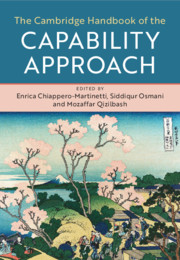Book contents
- The Cambridge Handbook of the Capability Approach
- The Cambridge Handbook of the Capability Approach
- Copyright page
- Dedication
- Contents
- Figures
- Tables
- Contributors
- Foreword
- Acknowledgements
- General Introduction
- Part I Historical Antecedents and Philosophical Debates
- Part II Methods, Measurement and Empirical Evidence
- Introduction to Part II
- 13 Social Choice and the Capability Approach
- 14 On Capability and its Measurement
- 15 Analyzing Capabilities
- 16 Implementing the Capability Approach with Respect for Individual Valuations
- 17 Capability, Opportunity, Outcome and Equality
- 18 The Distribution of Capabilities
- 19 Inter-Group Disparities in the Distribution of Human Development
- 20 Multidimensional Inequality and Human Development
- 21 The Research Agenda on Multidimensional Poverty Measurement
- 22 Measuring Gender Inequality Using the Capability Approach
- 23 Econometric and Statistical Models for Operationalizing the Capability Approach
- 24 Expanding Capabilities through Participatory Action Research
- Part III Issues in Public Policy
- Index
- References
13 - Social Choice and the Capability Approach
from Part II - Methods, Measurement and Empirical Evidence
Published online by Cambridge University Press: 11 November 2020
- The Cambridge Handbook of the Capability Approach
- The Cambridge Handbook of the Capability Approach
- Copyright page
- Dedication
- Contents
- Figures
- Tables
- Contributors
- Foreword
- Acknowledgements
- General Introduction
- Part I Historical Antecedents and Philosophical Debates
- Part II Methods, Measurement and Empirical Evidence
- Introduction to Part II
- 13 Social Choice and the Capability Approach
- 14 On Capability and its Measurement
- 15 Analyzing Capabilities
- 16 Implementing the Capability Approach with Respect for Individual Valuations
- 17 Capability, Opportunity, Outcome and Equality
- 18 The Distribution of Capabilities
- 19 Inter-Group Disparities in the Distribution of Human Development
- 20 Multidimensional Inequality and Human Development
- 21 The Research Agenda on Multidimensional Poverty Measurement
- 22 Measuring Gender Inequality Using the Capability Approach
- 23 Econometric and Statistical Models for Operationalizing the Capability Approach
- 24 Expanding Capabilities through Participatory Action Research
- Part III Issues in Public Policy
- Index
- References
Summary
Social choice is concerned with the selection of an ideal (or social) option, which can be a so-called ‘social state’, or a social ‘utility’, or a social ‘preference’, or a social choice ‘set’, on the basis of individual utilities, or individual utility functions, or individual preferences, or individual choice sets, or individual choice functions. A number of scholars have outlined the limited aspect of the notion of utility, including, notably and pre-eminently, Amartya Sen and Martha C. Nussbaum. Although they did not put it in such a strong phrase, the basic idea is to replace the notion of utility by the notion of capability (leaving aside ‘happiness’, a notion which for many is hardly distinguishable from utility). As has been remarked by Mozaffar Qizilbash, the development of the capability approach has been focused on the capability of an individual; and the idea of amalgamating or aggregating individual data is consubstantial with social choice. The purpose of this text is to propose some preliminary ideas regarding the aggregation of individual capabilities.
Keywords
- Type
- Chapter
- Information
- The Cambridge Handbook of the Capability Approach , pp. 253 - 270Publisher: Cambridge University PressPrint publication year: 2020

